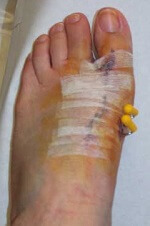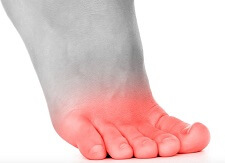- Home
- Common Foot Problems
- Bunions
- Surgery
Bunion Operation
Written By: Chloe Wilson BSc(Hons) Physiotherapy
Reviewed By: FPE Medical Review Board
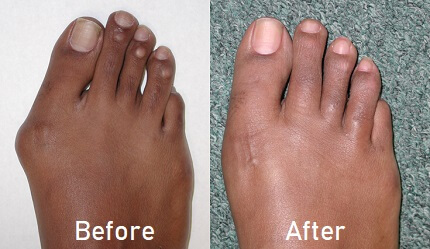
A bunion operation is the only long term cure for bunions and is performed only if other treatments have failed to reduce your symptoms.
Bunions, also known as hallux abducto valgus, are caused by the big toe shifting out of position towards the second toe, resulting in the characteristic bump on the side of the foot.
Surgery for bunions aims to correct the position of the toes, thus relieving pain and discomfort. Every hallux valgus is slightly different so there are a whole range of operations out there.
Here, we will look at the indications for surgery, the different types of operation commonly used, the recovery process and whether bunion laser surgery is appropriate. If you want to find out more background information, visit the overview and treatment sections.
Indications for A Bunion Operation
In most cases, a hallux valgus can be treated conservatively i.e. without surgery using simple methods such as changing to wider fitting shoes, using toe splints and medication – find out more in the bunion treatment section.
However, in some cases bunion symptoms become severe enough to warrant surgical intervention. People typically benefit from a bunion operation:
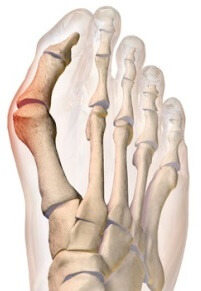
- Severe Pain: If you are suffering from frequent, severe episodes of pain that can’t be controlled with medication or rest, you may benefit from a bunion operation
- Decreased Activity Levels: If pain and stiffness are markedly affecting your day-to-day activities such as walking despite using analgesia and wearing appropriate footwear
- Inflammation: If there is swelling around the toe that doesn’t improve with medication, rest, ice and elevation, surgery may be recommended
- Stiffness: If the toe becomes so stiff that you can’t bend it, it may affect how you walk and cause secondary problems such as back and knee pain
- Toe Deformity: If the toe has drifted so far over that it is affected the neighboring toe or again is affecting how you walk, surgery may be advised
- Other Treatments Have Failed: Conservative treatments should be tried first for at least six months and surgery only considered if they have failed to help
Bunion surgery should never be done as a preventative measure or for purely cosmetic reasons as there are risks associated with any type of surgery.
Types Of Bunion Operation
Surgery for bunions is carried out by an orthopedic surgeon and may involve one or a combination of the following:
- Removing part of the bone: either simply shaving off the lump or removing larger portions of bone to correct the angle
- Moving the position of the soft tissues around the bone: making them longer or shorter to hold the toe in a better position
- Changing the position of one of the metatarsal bones: the long foot bone that attaches to the toe
- Fusing the affected toe joint: removing the damaged bits of bone and holding the toe in place with screws, plates or wire
As every bunion is slightly different, there is no one way to operate on them – your surgeon will evaluate your hallux valgus and decide on the best way to treat it. The most common bunion operations are:
1. Exostectomy (Mild cases)
An exostectomy bunion operation is where the bump on the toe joint is removed, often referred to as being shaved off. This is only done with mild bunions as it doesn’t correct the position of the toe, it simple removes the lump. One example of this is the Silvers Procedure
2. Osteotomy (Moderate to Severe)
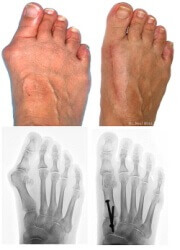
An osteotomy bunion operation is when sections of bone are removed from the end of the metatarsal (where it meets the toe) and sometimes the head as well (where it meets the midfoot).
The bony lump on the edge of the toe will be removed along with some extra portions of bone to allow the joint to be realigned into the correct position.
Osteotomy surgery is often combined with a soft tissue realignment. Screws may be used to hold the bone in place. One example of this type of bunion operation is a Basal Wedge Osteotomy.
3. Soft Tissue Realignment (All Cases)
In most cases, bunions are associated with tightening of ligaments or tendons that pull on the bone, causing it to drift out of normal alignment. During soft tissue realignment bunion surgery, loose tissues are shortened and tight tissues are lengthened.
In virtually every type of bunion operation, there will be some surgery on the tendons and ligaments as part of the procedure.
4. Arthrodesis aka Fusion (Severe)
With an arthrodesis bunion operation, the damaged parts of the joint are removed. The joint is then fused i.e. held together with wires, screws or plates. This locks the joint, making it so stiff that it is unable to move.
This type of bunion operation is only carried out on those with severe bunions or arthritis or if previous surgeries have failed. You will not be able to wear high heels after this type of bunion operation.
5. Excision Arthroplasty (Severe Cases)
Also known as a Resection Arthroplasty or Keller’s Arthroplasty, this bunion surgery involves removing the damaged portion of bone at the toe joint which leaves a space. The soft tissues are held together with wire until scar tissue forms a false joint in the space. An excision arthroplasty bunion operation is usually only carried out in the elderly or with severe arthritis.
Some bunion operations combine a number of these techniques into one, such as the Lapidus Procedure where the toe is straightened with a combination of osteotomies to removed damaged sections of bone, realignment of the soft tissues and fusion of the first tarsometatarsal joint (metatarsal head and the midfoot) with the bones being held together with screws until new bone grows.
What Happens During Bunion Surgery?
Bunion operations are usually carried out as an out-patient meaning you can go home the same day.
You might be given a general anaesthetic, where you are put to sleep, or an ankle block, where you are awake but your foot is numb. A bunion operation usually takes around 30-60 minutes.
Recovery Following A Bunion Operation
People usual recover well after a bunion operation. You can usually go home the same day as the surgery. You will have special dressings on the foot and be given a special shoe to wear. You may be given crutches to use initially to help you get around. Walking should be kept to a minimum initially following a bunion operation.
The foot will likely be swollen for 3-6 months. You will gradually be able to increase how much you walk and will be given exercises for the foot.
85% of people make a full recovery from a bunion operation, and much of this is related to how well they follow their post-op instructions. You can find out more in the bunion surgery recovery section.
Bunion Laser Surgery
Many people ask if it is possible to have bunion laser surgery thinking it will cause less damage and scarring, and result in a faster healing time. In actual fact, there is no advantage in bunion laser surgery over traditional methods.
Lasers work best for treating soft tissues rather than bone and in most cases, bunion surgery involves operating on the bone. Therefore bunion laser surgery is not appropriate.
What Else Can Help?
You can find out more about bunions in the following sections:
- Bunion Guide: An overview of bunions including common causes
- Symptoms: Includes both classic and less common symptoms
- Treatment Options: Best treatments including orthotics and exercises
- Recovering from Surgery: Recovery guide following bunion operation
- Top Products: Things that can help with prevention or recovery from surgery
Bunions are just one possible cause of toe pain and foot lumps and bumps. If you want to know more about other common foot problems, visit the foot pain diagnosis guide.
Page Last Updated: 01/25/24
Next Review Due: 01/25/26

